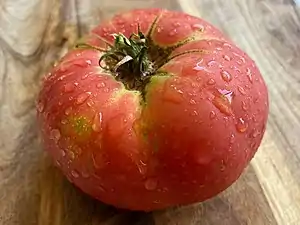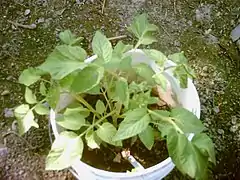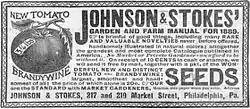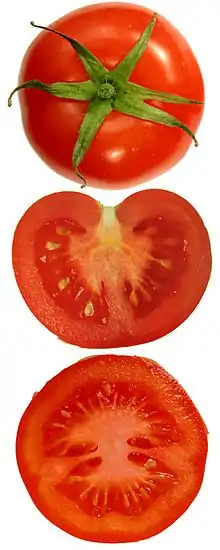Brandywine (tomato)
The Brandywine tomato plant is an heirloom cultivar of the species, with large potato-leaved foliage and which bears large pink beefsteak-shaped fruit, popularly considered among the best tasting available.
| Brandywine | |
|---|---|
 Brandywine fruit | |
| Tomato (Solanum lycopersicum) | |
| Maturity | 90 days |
| Type | Heirloom |
| Vine | Indeterminate |
| Plant height | 9 feet |
| Fruit Weight | 24 oz |
| Leaf | Potato leaf |
| Color | Pink |
| Shape | Beefsteak |
Description
Brandywine tomatoes can bear fruit up to 1.5 lbs (0.7 kg), requiring 80 to 100 days to reach maturity, making it among the slowest maturing varieties of common tomato cultivars. Brandywine has been described as having a "great tomatoey flavor",[1] (others have called it a sandwich sized tomato that is offset by a wonderful acidity), leading to heavy usage despite the original cultivar's relatively low yield per plant. Its fruit has the beefsteak shape and mixed red and deep purple flesh. Even when fully ripe, the tomato can have green shoulders near the stem.

The Brandywine tomato plant also has potato leaves, an unusual variation on the tomato plant, whose leaves are smooth and oval with a pointy tip, instead of jagged and fjord-like the way "normal" tomato plant leaves are.
History

As noted by Craig LeHoullier, the origins of the Brandywine cultivar remain unclear.[2] Burpee reports carrying it in their catalogue as early as 1886, and there are references to it older than that.[1] Though it is often said to be of Amish origins, there is no evidence of this.[2]
LeHoullier also notes, it had been included in the Seed Savers Exchange in 1982 by an elderly Ohio gardener named Ben Quisenberry. He received the variety from a woman named Dorris Sudduth Hill who could trace Brandywine in her family for over 80 years. Brandywine has become one of the most popular home garden cultivars in the United States. Due to the proliferation of many misidentified varieties, the pink-fruited, potato-leaved Brandywine is sometimes labeled Brandywine (Sudduth's).[2]
See also
References
- Klingaman, Gerald (August 6, 2004). "Plant of the Week: Brandywine Tomato". University of Arkansas Cooperative Extension Service. Retrieved April 9, 2007.
- LeHoullier, Craig (2002). "A History of the Brandywine Tomatoes". Victory Seed, Web Grower newsletter. Retrieved July 30, 2018.
Further reading
- Klingaman, Gerald (August 10, 2004). "Brandywine tomatoes and the history of genetic study". Delta Farm Press. Retrieved 26 August 2013.
